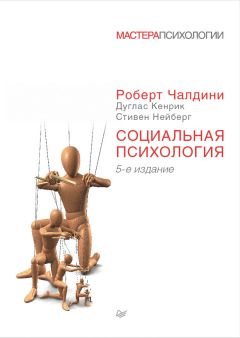Филип Зимбарго - Социальное влияние
Jones, E.E., and Harris, V.A. (1967). The attribution of attitudes. Journal of Experimental Social Psychology, 3, 2–24.
Jones, E. E., Rock, L., Shaver, K. G., Goethals, G. R., and Ward, L. M. (1968). Pattern of performance and ability attribution: An unexpected primacy effect. Journal of Personality and Social Psychology, 10, 317–340.
Sudd, С M., Kenny, D. A., and Krosnick, J. A. (1983). Judging the positions of political candidates: Models of assimilation and contrast. Journal of Personality and Social Psychology, 44, 952–963.
Kahn, D. (1987). It's a great ad, but will it sell? Newsday, Mar. 29, 80, 77.
Kahneman, D. (1973). Attention and effort. Engle — wood Cliffs, NJ: Prentice — Hall.
Kahneman, D., and Tversky,A. (1979). Prospect theory: An analysis of decision under risk. Econometrica, 47, 263–291.
Kalfus, G. R., Ferrari, J. R., Arean, P., Balser, D., Cotronea, R., Franco, M., and Hill, W. (1987). An examination of the New York mandatory seat belt law on a university campus. Law and Human Behavior, 11, 63–67.
Kallgren, С A., and Wood, W. (1986). Access to attitude — relevant information in memory as a determinant of attitude — behavior consistency. Journal of Experimental Social Psychology, 22, 328–338.
Kalven, H., and Zeisel, H. (1966). The American jury. Boston: Little, Brown.
Kamenetsky, С. (1984). Children's literature in Hitler's Germany: The cultural policy of National Socialism. Athens, OH: Ohio University Press.
Kandel, D. В., Kessler, R. С and Marguties, R. L. (1978). Antecedents of adolescent initiation into stages of drug use: A developmental analysis. Journal of Youth and Adolescence, 7, 13–40.
Kantola, S. J., Syme, G. /., and Campbell, N. A. (1984). Cognitive dissonance and energy conservation. Journal of Applied Psychology, 69,416–421.
Kaplan, M.F., and Miller, С. E. (1987). Group decision making and normative versus informational influence: Effects of type of issue and assigned decision rule. Journal of Personality and Social Psychology, 53, 306–313.
Karabenick, S.A. (1983). Sex — relevance of context and influenceability, Sistrunk and McDavid revisited. Personality and Social Psychology Bulletin, 9, 243–252.
Kassin, S. M., and Wrightsman, L. S. (1980). Prior confessions and mock jury verdicts. Journal of Applied Social Psychology, 10, 133–146.
Kassin, S. M., and Wrightsman, L. S. (1981). Coerced confessions, judicial instruction, mock juror verdicts. Journal of Applied Social Psychology, 11,489–506.
Kassin, S. M., Reddy,M.E., and Tulloch, W. F. (1990). Juror interpretations of ambiguous evidence: The need for cognition, presentation order, and persuasion. Law and Human Behavior, 14, 43–55.
Kates, R. W. (1976). Experiencing the environment as hazard. In H. M. Proshansky, W. H. Ittelson, and L. G. Rivlin (Eds.), Environmental psychology: People and their physical settings (2d ed.). New York: Holt, Rinehart & Winston.
Katz, D. (1960). The functional approach to the study of attitudes. Public Opinion Quarterly, 24, 163–204.
Keeton, R. E. (1973). Trial tactics and methods (2d ed.). Boston: Little, Brown.
Kelley, H. H. (1967). Attribution theory in social psychology. In D. Levine (Ed.), Nebraska symposium on motivation (vol. 51). Lincoln: University of Nebraska Press.
Kelley, H.H. (1972). Causal schemata and the attribution process. In E. E. Jones, D. E. Kanou — se, H. H. Kelley, R. E. Nisbett, S. Valins, and B. Weiner (Eds.), Attribution: Perceiving the causes of behavior. Morristown, NJ: General Learning Press.
Kendall, P. С (1987). Cognitive processes and procedures in behavior therapy. In G. T. Wilson, С M. Franks, P. С Kendall, and J. P. Foreyt (Eds.), Review of behavior therapy, theory and practice (vol. 11). New York: Guil — ford.
Key,W.B. (1973). Subliminal seduction. Engle — wood Cliffs, NJ: Signet.
Kiesler, С. А. (1971). The psychology of commitment: Experiments linking behavior to belief. New York: Academic Press.
Kihlstrom, J. F. (1987). The cognitive unconscious. Science, 237, 1445–1452.
Kinder, D. R., and Sears, D. O. (1981). Prejudice and politics: Symbolic racism versus racial threats to the good life. Journal of Personality and Social Psychology, 40, 414–431.
King, В. Т., and Janis, I. L. (1956). Comparison of the effectiveness of improvised versus non — improvised role — playing in producing opinion change. Human Relations, 9, 177–186.
Kircher, J. C, Horowitz, S. It7., and Raskin, D. С (1988). Meta — analysis of mock crime studies of the control question polygraph technique. Law and Human Behavior, 12, 79–90.
Kleinhesselink, R. /?., and Edwards, R. E. (1975). Seeking and avoiding belief — discrepant information as a function of its perceived refutability. Journal of Personality and Social Psychology, 31,787–790.
Koehnken, G. (1985). Speech and deception of eyewitnesses: An information processing approach. In F. L. Denmark (Ed.), Social/ecological psychology and' the psychology of women (pp. 117–139). New York: Elsevier Science Publishers.
Krauss, R. M., Apple, W., Morency, N'., Wenzel, C, and Winton,W. (1981). Verbal, vocal, and visible factors in judgments of another's affect. Journal of Personality and Social Psychology, 40, 312–320.
Kraut, R. (1980). Humans as lie detectors: Some second thoughts. Journal of Communications, 30(4), 209–216.
Kraut, R. E., and Рое, D. (1980). Behavioral routes of person perception: The deception judgments of customs inspectors and laymen. Journal of Personality and Social Psychology, 39, 784–798.
Krosnick,]. A. (1988). The role of attitude importance in social evaluation: A study of policy preferences, presidential candidate evaluations, and voting behavior. Journal of Personality and Social Psychology, 55, 196–210.
Kruglanski,A. W., and Mayseless, O. (1987). Motivational effects in the social, comparison of opinions. Journal of Personality and Social Psychology, 53, 834–842.
Kunst — Wilson, W. R., and Zajonc, R. B. (1980). Affective discrimination of stimuli that cannot be recognized. Science, 207, 557–558.
Kyle,S.O.. and Falbo, T. (1985). Relationships between marital stress and attributional preferences for own and spouse behavior. Journal of Social and Clinical Psychology, 3, 339–351.
Landers, S. (1990). Sex, condom use up among teenage boys. АРА Monitor, Apr., 25.
Landy,D. (1972). The effects of an overheard audience's reaction and attractiveness on opinion change. Journal of Experimental Social Psychology, 8, 276–288.
Langer, E. (1989). Mindfulness. Reading, MA: Addison — Wesley.
Langer, E., and Abelson, R. P. (1974). A patient by any other name…: Clinical group differences in labelling bias. Journal of Consulting and Clinical Psychology, 42, 4–9.
Langer, E., Blank, A., and Chanowitz, B. (1978). The mindlessness of ostensibly thoughtful action: The role of «placebic» information in interpersonal interaction. Journal of Personality and Social Psychology, 36, 635–642.
Langer, £., and Piper, A. (1987). The prevention of mindlessness. Journal of Personality and Social Psychology, 53, 280–287.
Lanzetta, 1. Т., Sullivan, D. G., Masters, R. D., and McHugo, G. J. (1985). Viewers' emotional and cognitive responses to televised images of political leaders. In S. Kraus and R. M. Perloff (Eds.), Mass media and political thought: An information processing approach (pp. 85–115). Beverly Hills, CA: Sage.
Lee,M. Т., and Ofshe, R. (1981). The impact of behavioral style and status characteristics on social influence: A test of two competing theories. Social Psychology Quarterly, 44, 73–82.
Leippe, M. R. (1979). Message exposure duration and attitude change: An information processing analysis of persuasion. Unpublished doctoral dissertation, Ohio State University.
Leippe, M. R.(1980). Effects of integrative memorial and cognitive processes on the correspondence of eyewitness accuracy and confidence. Law and Human Behavior, 4, 261–274.
Leippe, M. R. (1983). Persuasion, cognitive responses, and message exposure duration: Evidence for thought reversal. Paper presented at the meeting of the Eastern Psychological Association.
Leippe, M. R., and Elkin, R. A. (1987). When motives clash: Issue involvement and response involvement as determinants of persuasion. Journal of Personality and Social Psychology, 52, 269–278.
Leippe, M. R., and Romanczyk.A. (1989). Reactions to child (versus adult) eyewitnesses: The influence of jurors' preconceptions and witness behavior. Law and Human Behavior, 13, 103–131.
Leippe, M. R., Romanczyk, A., and Manion, A. P. (1990). Eyewitness persuasion: How and how well do factfinders judge the accuracy of adults' and children's memory reports. Manuscript submitted for publication, Adelphi University.
Leippe, M.R., Wells, G.L., and Ostrom., T.M. (1978). Crime seriousness as a determinant ot
accuracy in eyewitness identification. Journal ol Applied Psychology, 63, 345–351.
Lepper,M.R., Greene, D., and Nisbett,R.E. (1973). Undermining children's intrinsic interest with extrinsic reward: A test of the overjustifica — tion hypothesis. Journal of Personality and Social Psychology, 28, 129–137.
Leventhal, H. (1970). Findings and theory in the study of fear communications. In L. Berkowitz (Ed.), Advances in experimental social psychology (vol. 5). New York: Academic Press.
Leventhal, H., Watts, J. C, and Pagano, F. (1967). Effects of fear and instructions on how to cope with danger. Journal of Personality and Social Psychology, 6, 313–321.
Lewisohn, P. M., Mischel, W., Chapline, W., and Barton, R. (1980). Social competence and depression: The role of illusory self — perceptions. Journal of Abnormal Psychology, 89, 203–212.
Liebert, R. M., and Spra[kin, J. (1988). The early window: Effects of television on children and youth (3d ed.). New York: Pergamon.
Lifton,R.K. (1969). Thought reform and the psychology of totalism. New York: Norton.
Lind, E.A. (1982). The psychology of courtroom procedure. In N. L. Kerr and R. M. Bray (Eds.), The psychology of the courtroom (pp. 13–38). New York: Academic Press.
Lind, E. A., Erickson, В., Conley, J. M., and O'Barr, W.M. (1978). Social attributions and conversational style in trial testimony. Journal of Personality and Social Psychology, 36, 1558–1567.
Lind, E. A., Thibault,]., and Walker, L. (1973). Discovery and presentation of evidence in adversary and nonadversary proceedings. Michigan Law Review, 71, 1129–1144.
Lindsay, R. С L., Wells, G. L., and Rumpel, C. (1981). Can people detect eyewitness identification accuracy within and between situations? Journal of Applied Psychology, 66, 79–89.
Loftus, E.F. (1979). Eyewitness testimony. Cambridge, MA: Harvard University Press.
Loftus, E. F. (1974). Reconstructing memory: The incredible witness. Psychology Today, Dec, 116–119.
Loftus, E. F. (1984). Eyewitnesses: Essential but unreliable. Psychology Today, Feb., 22–26.
Loftus, E. F., Miller, D. G., and Burns, H. J. (1978). Semantic integration of verbal information into a visual memory. Journal of Experimental Psychology: Human Learning and Memory, 4, 19–31.
London, H. (1973). Psychology of the persuader. Morristown, NJ: General Learning Press.
Lord, С G., Lepper, M. R., and Preston, E. (1984). Considering the opposite: A corrective strategy for social judgment. Journal of Personality and Social Psychology, 47, 1231–1243.
Lord, С. О., Ross.L., and Lepper, M.R. (1979). Biased assimilation and attitude polarization: The effects of prior theories on subsequently considered evidence. Journal of Personality and Social Psychology, 37, 2098–2109.
Luchlns,A. (1957). Primacy — recency in impression formation. In C. I. Hovland (Ed.), The order of presentation in persuasion. New Haven, CT: Yale University Press.
Luthans.F., Paul,R., and Baker, D. (1981). An experimental analysis of the impact of contingent reinforcement on salespersons' performance behavior. Journal of Applied Psychology, 66,314–323.
Lutz, W. (1989). No one died in Tiananmen Square. The New York Times, July 12, Al, A9.
Luus, C.A.E., and Wells, G. L. (1991). Eyewitness identification and the selection of distractors for lineups. Law and Human Behavior, in press.
Lydon, J. E., and Zanna, M. P. (1990). Commitment in the face of adversity: A value — affirmation approach. Journal of Personality and Social Psychology, 58, 1040–1047.
Maccoby, N., Farquhar, J. W., Wood, P. D., and Alexander, J. (1977). Reducing the risk of cardiovascular disease: Effects of a community — based campaign on knowledge and behavior. Journal of Community Health, 3, 100–114.




